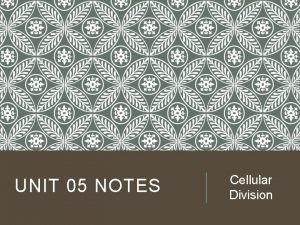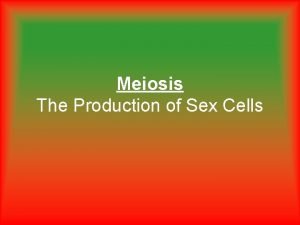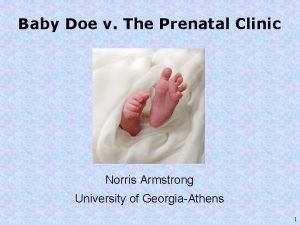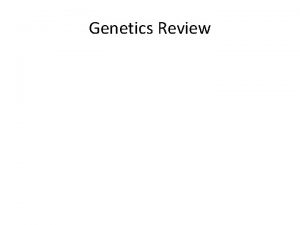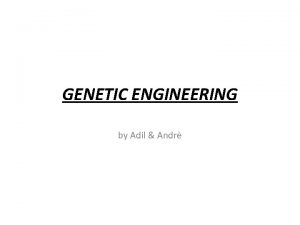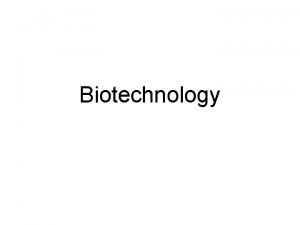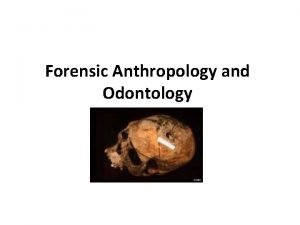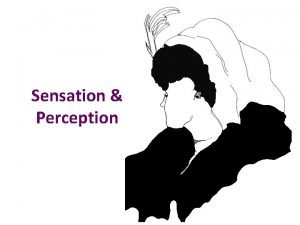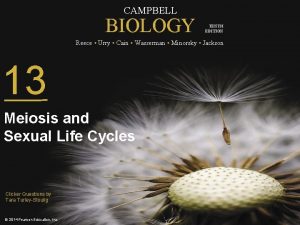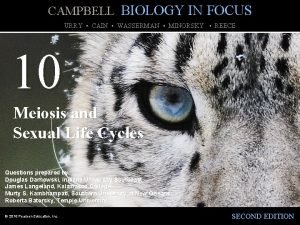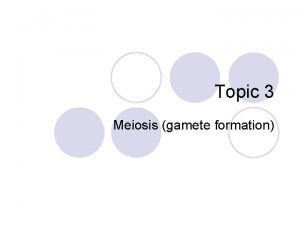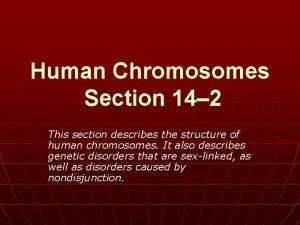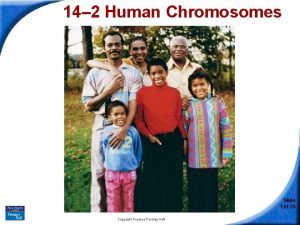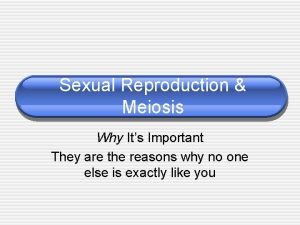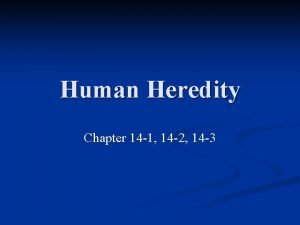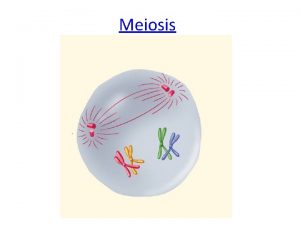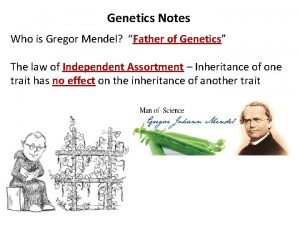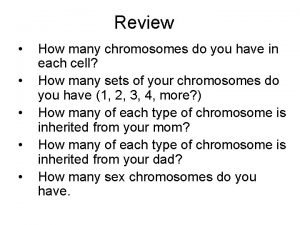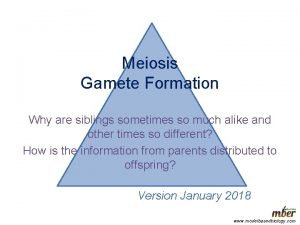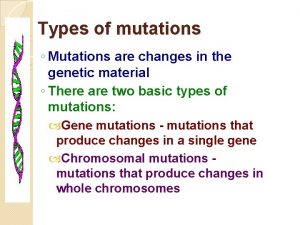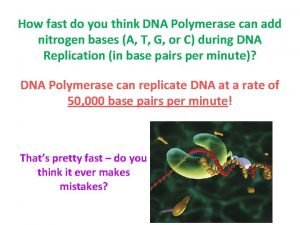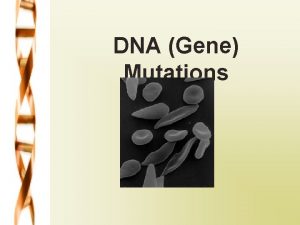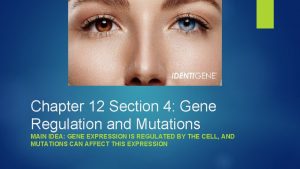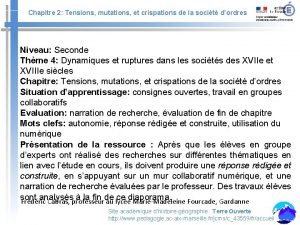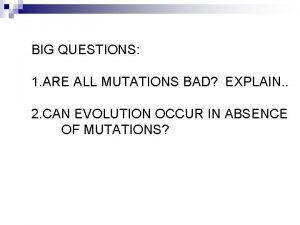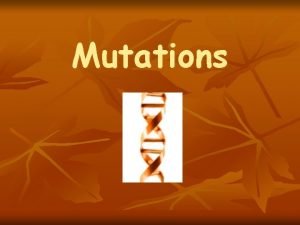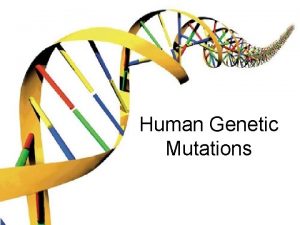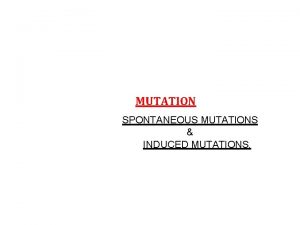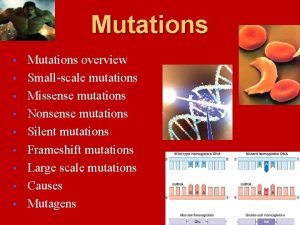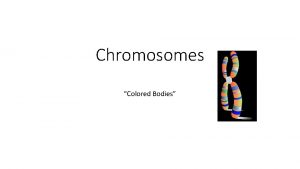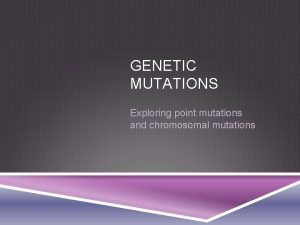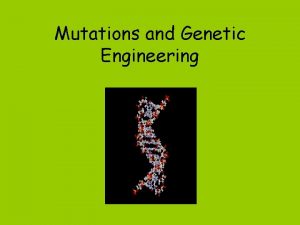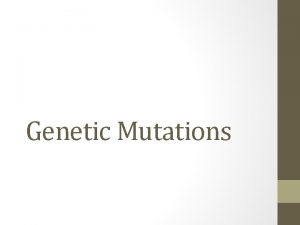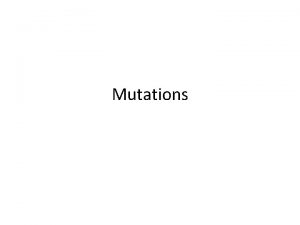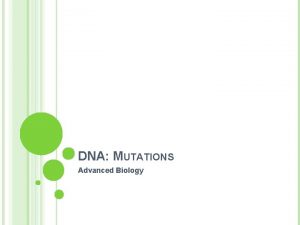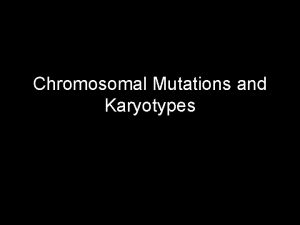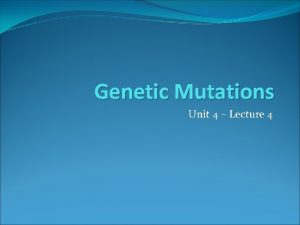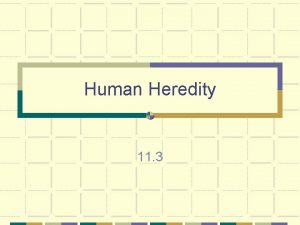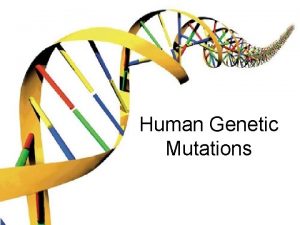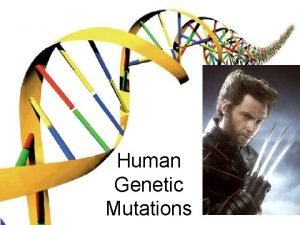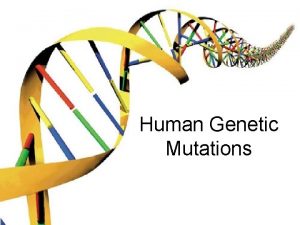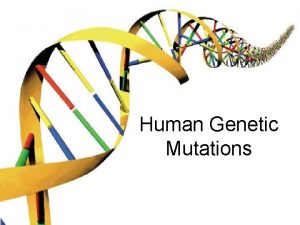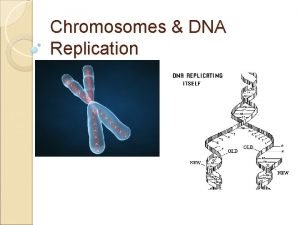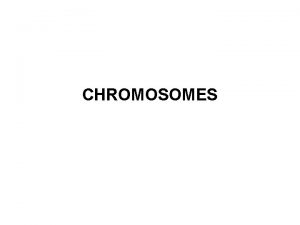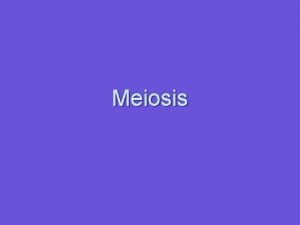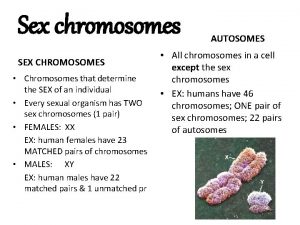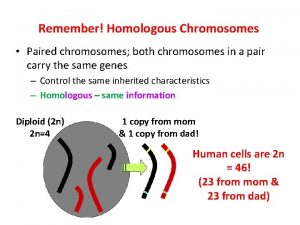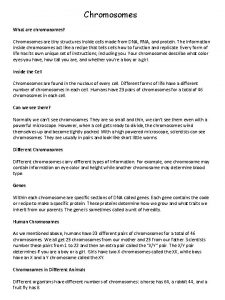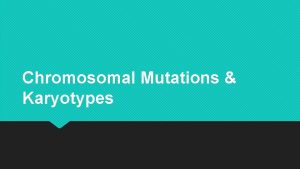Human Genetic Mutations What are chromosomes Humans have







































- Slides: 39

Human Genetic Mutations

What are chromosomes? • Humans have 23 pairs of chromosomes, with one chromosome from each parent. • The chromosomes are coiled up DNA. • Under normal conditions all of the chromosomes are inherited in tact. This i s huma a normal ka n r is a p chromosom yotype of ict e up to ure of chro s. A karyo look a t moso mes l ype t and ined comp are.

2 Main Types of Mutations 1. ) Chromosomal Mutations 2. ) Gene Mutations

Chromosomal Mutations • Any change in the structure or number of chromosomes • 5 Types 1. 2. 3. 4. 5. Deletion Duplication Inversion Translocation Non. Disjunction

Deletion One or more genes are removed

Duplication A segment of genes is copied twice and added to the chromosome

Inversion a segment of genes flip end-to-end on the chromosome

Translocation Material is swapped with another chromosome

Nondisjunction • Chromosomes FAIL TO SEPARATE during meiosis

Nondisjunction • Produces gametes (and therefore a baby) with one missing chromosome or one extra chromosome

Nondisjunction (in Meiosis II)

Fertilization

Nondisjunction • Every cell in that baby’s body will have 3 copies of this chromosome instead of 2. • This condition is called TRISOMY • Trisomy 21 = Individual has 3 copies of chromosome # 21. • As a result the child will have Down Syndrome

Genetic Screening - Amniocentesis

Karyotypes • A pictorial display of metaphase chromosomes from a mitotic cell • Homologous chromosomes- pairs • Chromosomes pairs 1 -22 are called autosomes • Chromosome pair 23 are called the sex chromosomes

Trisomy 21 - Down Syndrome

Klinefelter’s Syndrome • Due to nondisjunction • Chromosome makeup is XXY • Creates a sterile male

Turner’s Syndrome • Due to nondisjunction • Monosomy- the condition in which there is a missing chromosome. • Sex chromosome make up is X only • Females that will not undergo puberty.


Edward’s Syndrome • Due to nondisjunction • Extra number 18 chromosome (trisomy 18) • Traits: Low ears, kidney and heart defects


Patau’s Syndrome • Extra number 13 chromosome (trisomy 13) • Traits: Deformed eyes, ears and lips


Gene Mutations • One gene is affected • Any change to the DNA sequence of a gene: Nucleotides/Bases may be added, missing, or changed

Gene Mutations: 2 Types 1. Point Mutation 2. Frameshift Mutation

Point Mutation • One base (A, T, C, or G) is substituted for another • Can Cause: Sickle-cell anemia • 3 Possible Consequences: – nonsense mutations: code for a stop, which can translate the protein – missense mutations: code for a different amino acid – silent mutations: code for the same amino acid

Frameshift Mutation • One or more bases (A, T, C, or G) are added or deleted • Can Cause: Cystic Fibrosis • Caused by: – Insertion: adding a base – Deletion: removing a base

Causes of Mutations • spontaneous • occur during DNA replication • Caused by MUTAGENS • physical, ex: radiation from UV rays, X-rays or extreme heat • or chemical (molecules that misplace base pairs or disrupt the helical shape of DNA).

Example: Sickle Cell Anemia Normal Red Blood Cell • Red blood cells shaped like a disc • Hemoglobin (protien) carries oxygen to all parts of the body Sickle Red Blood Cell • • • Red blood cells form an abnormal crescent shape Hemoglobin (protein) is abnormally shaped don't move easily through your blood vessels form clumps and get stuck in the blood vessels Mutation located on Chromosome 11 Effects mostly African Americans


Example: Cystic Fibrosis (CF) • What is it? – disorder found on Chromosome 7 • Symptoms – Thick mucus in the lungs and digestive track – Constant lung infections and impaired digestion

Cause of Cystic Fibrosis (CF) • The “CFTR” gene is mutated – 3 base pairs are deleted • Mutant protein is missing an amino acid and cannot fold correctly vs


Albinism • Due to the lack of the pigment melanin (a protein) in the skin, eyes, and hair.

Hemophilia • Disorder that is linked to the sex chromosomes • Missing a protein needed for the blood to clot

Tay-Sachs Disease • Inability to synthesize an enzyme that prevent lipid buildup in brain cells. • Causes the breakdown of nervous system

Phenylketonuria (PKU) • Inability to code for an enzyme needed for changing the amino acid phenylalanine to tyrosine. • Damages brain cells and causes mental retardation.

Duchenne Muscular Dystrophy • Linked to the sex chromosomes • Results in the progressive weakening and loss of skeletal muscle.

Colorblindness • Carried on the X of the sex chromosomes. • Occurs more frequently in males than females.
 Antigentest åre
Antigentest åre 23 chromosome pairs
23 chromosome pairs Number of chromosomes in meiosis
Number of chromosomes in meiosis How many chromosomes do humans have
How many chromosomes do humans have How many pairs of chromosomes
How many pairs of chromosomes Research on the pros and cons of genetic engineering
Research on the pros and cons of genetic engineering Single cell
Single cell Founder population
Founder population Genetic programming vs genetic algorithm
Genetic programming vs genetic algorithm Genetic programming vs genetic algorithm
Genetic programming vs genetic algorithm What is gene flow and genetic drift
What is gene flow and genetic drift What is the difference between genetic drift and gene flow
What is the difference between genetic drift and gene flow How many lower teeth
How many lower teeth How many senses do humans have
How many senses do humans have Privet shrubs and humans each have a diploid number of 46
Privet shrubs and humans each have a diploid number of 46 Privet shrubs and humans each have a diploid number of 46
Privet shrubs and humans each have a diploid number of 46 Jugular notch of the sternum
Jugular notch of the sternum Chromosomes human
Chromosomes human Section 14-2 human chromosomes
Section 14-2 human chromosomes 14-2 human chromosomes
14-2 human chromosomes 14-2 human chromosomes answer key
14-2 human chromosomes answer key How many chromosomes are in a human’s sex cells?
How many chromosomes are in a human’s sex cells? 14-2 human chromosomes
14-2 human chromosomes Gametes in mitosis
Gametes in mitosis What happens if you have 45 chromosomes
What happens if you have 45 chromosomes Three facts about meiosis
Three facts about meiosis How many chromosome does a sperm cell have
How many chromosome does a sperm cell have How many chromosomes do dogs have
How many chromosomes do dogs have Genetic effects on gene expression across human tissues
Genetic effects on gene expression across human tissues Polyploid
Polyploid Sides = 8 vertices = 8
Sides = 8 vertices = 8 What are some types of chromosomal mutations?
What are some types of chromosomal mutations? What are some neutral mutations
What are some neutral mutations Cytoplasm structure
Cytoplasm structure What can cause mutations
What can cause mutations Chapter 14 lesson 4 mutations
Chapter 14 lesson 4 mutations Section 4 gene regulation and mutations
Section 4 gene regulation and mutations Tensions mutations et crispations de la société d'ordres
Tensions mutations et crispations de la société d'ordres Are all mutations bad? explain.
Are all mutations bad? explain. A permanent change
A permanent change

